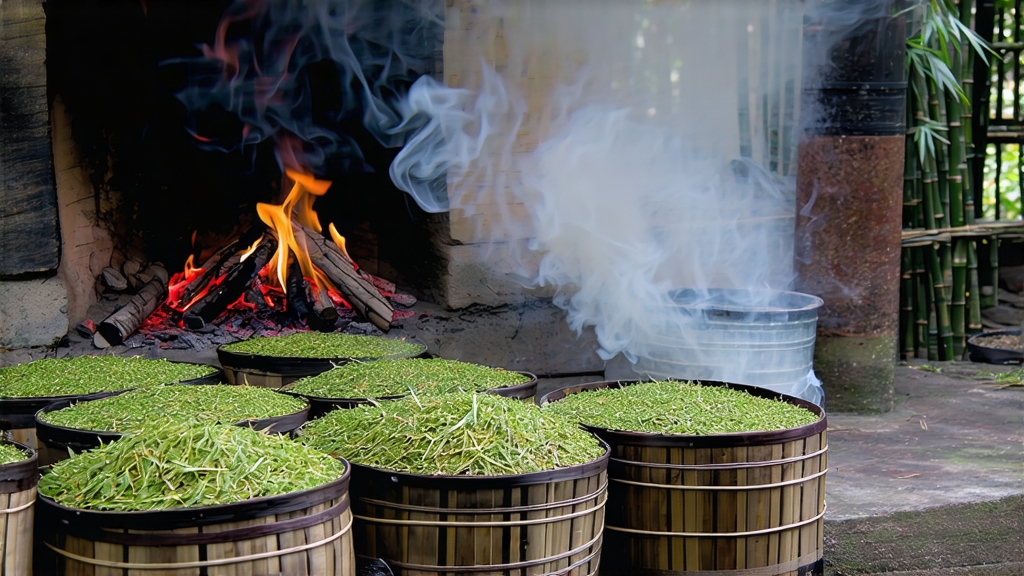
When European tea drinkers first encountered the dark, crimson liquor that arrived in Amsterdam and London during the early seventeenth century, they called it “black tea,” yet the Chinese who created it knew it by another name: hong cha, “red tea.” The very first of these reds to leave China’s shores was Lapsang Souchong, a leaf born in the rocky, mist-locked Wuyi Mountains of northern Fujian. From its humble Song-dynasty origins as a local monks’ medicine to its present-day cult following among whisky blenders and Michelin chefs, Lapsang Souchong has remained both misunderstood and adored—an tea that carries the perfume of pine forests and the memory of caravans that once rattled toward the Russian steppe.
History: From Misty Cloisters to Global Cups
Legend places the birth of Lapsang Souchong around 1567, when passing Qing-era armies requisitioned the last fresh leaves from Tongmu village. To hasten drying before the troops returned, farmers spread the leaves over pine fires; the resulting smoky aroma proved irresistible. By 1604 Dutch traders had ferried the tea to Europe, where it fetched prices higher than silver and inspired the English to plant stolen cuttings in the Himalayas, ultimately giving rise to the Indian tea industry. The name itself is a Cantonese phonetic rendering of “Zheng Shan Xiao Zhong”—“small leaf from the original mountain”—a geographic stamp that today is protected under China’s National Product Origin Mark.
Micro-Terroirs within Tongmu
Authentic Lapsang Souchong can only be produced inside the 600–1,200 m core zone of the Wuyi UNESCO reserve, an area of barely 36 km². Three micro-terroirs are recognised by local tea masters:
- Guadun: cool air funnels through a granite gorge, yielding leaves high in linalool and geraniol; the cup is sweetly floral, almost honey-like, with only a whisper of smoke.
- Miaowan: higher humidity and iron-rich soils produce a thicker leaf; the smoke bonds to tannins here, creating a whisky-ish, peaty character prized in the Baltic markets.
- Leishi: the steepest plots, shrouded in fog until noon, give slow-growing buds rich in amino acids; when smoked, these develop a resinous, incense-like note reminiscent of frankincense.
Each terroir is harvested only once a year, between Qingming and Grain Rain, when two leaves and a bud are still tightly curled and the spring bamboo aroma drifts across the narrow mountain paths.
Craft: Where Fire Meets Leaf
Unlike modern black teas that oxidise in mechanical tumblers, Lapsang Souchong is still coaxed by hand through a twelve-step ritual that lasts three consecutive nights.
Withering: Fresh leaves are laid on bamboo screens set above shallow pine trenches. A gentle smoulder—never a flame—raises the ambient temperature to 28 °C while resinous vapours drift upward, softening cell walls within 60 minutes.
Rolling: Once the leaves feel like soft leather, they are rolled in 3 kg bundles inside cotton cloth, twisted just enough to bruise epidermal cells without breaking them; this preserves the bud’s silver tip and prevents harshness.
Oxidation: The bundles rest in pine-wood crates lined with wet cloth. Enzymatic browning proceeds for 4–5 hours while the leaf temperature is kept below 32 °C; masters sniff the air every 20 minutes, waiting for the precise moment when green grassiness gives way to dried longan fruit.
Pan-firing: A 260 °C wok flash-halts oxidation in 45 seconds, locking in a mahogany colour and caramelising surface sugars.
Smoke-drying: The critical signature. The leaves are spread 2 cm thick on bamboo trays slid into a loft above a pinewood hearth. Freshly cut Masson pine and a little cedar are ignited, then smothered to produce cool, aromatic smoke that circulates for 8–10 hours. Masters control draught by adjusting ceiling tiles, ensuring the temperature never exceeds 80 °C so that the leaf remains pliable and the smoke adheres to the inner cortex, not merely the surface.
Sorting & Aroma Rest: After smoking, the tea is left to “dream” for 30 days in unglazed clay jars; moisture equalises